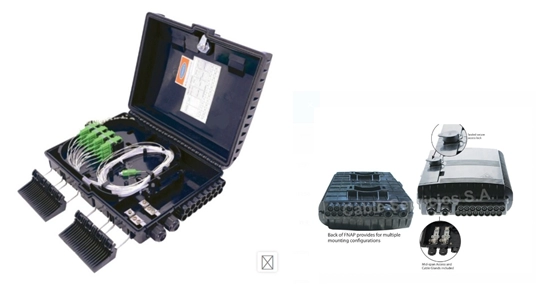
博客
blog 更新时间:2025-06-16
更新时间:2025-06-16 访问量:
访问量: 
The 16 core distribution box emerges as a versatile solution, designed to streamline the distribution of multi-core cables in various industrial, commercial, and residential applications. This article explores its design, key features, applications, and advantages, highlighting why it has become an essential component in modern infrastructure.
What Is a 16 Core Distribution Box?
A 16 core distribution box is a compact, durable enclosure designed to terminate, organize, and distribute cables with up to 16 individual cores (conductors or fibers). It serves as a central hub for connecting incoming cables from a main source (e.g., utility lines, data centers, or power grids) to multiple outgoing lines that feed into sub-systems or end-users. The box is typically made from materials like galvanized steel, aluminum, or high-grade plastic, ensuring resistance to environmental factors such as moisture, dust, and physical impact.
Key Design Features
1. High-Density Termination
· 16-core capacity: Supports up to 16 individual cables or fiber optic strands, ideal for applications requiring medium to high connectivity without excessive bulk.
· Modular terminals: Equipped with removable terminal blocks or splice trays, allowing easy installation, maintenance, and reconfiguration of connections.
2. Protective Enclosure
· Weatherproof construction: Many models feature an IP65 or higher ingress protection rating, making them suitable for outdoor use in harsh environments.
· Cable entry ports: Rubber grommets or sealed glands prevent dust and water from entering the box, safeguarding internal connections.
3. Organized Cable Routing
· Cable management brackets: Built-in hooks, clips, or trays keep cables neat and prevent tangling, reducing the risk of signal interference or mechanical damage.
· Labeling space: Clear panels or slots for labeling ports and cores, enhancing operational efficiency during troubleshooting or system upgrades.
4. Easy Access and Installation
· Hinged or removable lid: Allows quick access to internal components for inspection or repairs.
· Mounting options: Supports wall-mounting, pole-mounting, or rack-mounting, adapting to different installation environments.
Applications Across Industries
1. Telecommunications and Networking
· Fiber optic distribution: In FTTH (Fiber to the Home) networks, the box splits a main fiber optic cable into 16 individual connections for residential or commercial units, ensuring high-speed data delivery.
· LAN/WAN systems: Organizes Ethernet or coaxial cables in office buildings, data centers, or campus networks, simplifying cable routing and reducing downtime during maintenance.
2. Power Distribution
· Low-voltage systems: Manages power cables in residential complexes, hotels, or industrial facilities, distributing electricity from a main panel to sub-circuits for lighting, appliances, or machinery.
· Renewable energy: Connects multiple solar panels or wind turbine cables to a central inverter, optimizing power flow in green energy setups.
3. Industrial Automation
· Control systems: Routes signal cables for sensors, actuators, and PLCs (Programmable Logic Controllers) in factories, ensuring reliable communication between machines and control units.
· Heavy machinery: Used in mining, construction, or maritime environments to protect cables from dust, vibrations, and corrosive substances.
4. Smart Home and Building Automation
· Home networks: Centralizes connections for security cameras, smart thermostats, audio-visual systems, and IoT devices, creating a unified hub for smart home management.
· Lighting control: Distributes low-voltage cables for LED lighting systems, enabling centralized dimming, scheduling, and energy optimization.
Advantages of Using a 16 Core Distribution Box
1. Enhanced Cable Organization
· Eliminates clutter and reduces the risk of cable damage caused by tangling or excessive bending, extending the lifespan of cables and connections.
2. Flexibility and Scalability
· Modular design allows easy expansion (e.g., adding more terminals or upgrading to higher-core capacity) as network demands grow.
· Adaptable to different cable types (copper, fiber optic, coaxial) with compatible connectors and accessories.
3. Improved System Reliability
· Protective enclosures and secure terminations minimize signal loss, electrical faults, or environmental interference, ensuring stable performance.
· Simplified troubleshooting: Labeled ports and organized routing make it easier to identify and resolve connection issues quickly.
4. Cost and Time Efficiency
· Reduces installation time with pre-configured terminals and standardized mounting options.
· Lowers long-term maintenance costs by protecting cables from damage and streamlining system upgrades.
Technical Specifications (Typical Model)
Parameter | Specification |
Core Capacity | 16 cores (single or multi-mode for fiber) |
Material | Galvanized steel / ABS plastic / Aluminum |
Dimensions | 300mm (W) x 250mm (H) x 120mm (D) (customizable) |
Ingress Protection | IP65 (dust-tight, water jet-resistant) |
Operating Temperature | -20°C to +60°C (-4°F to 140°F) |
Cable Diameter Compatibility | 6mm to 25mm (0.24" to 0.98") |
Termination Type | Screw-down terminals, crimp connectors, or fusion splice trays (for fiber) |
For customized solutions or technical support, consult with leading manufacturers to select a model that best fits your specific application requirements.
